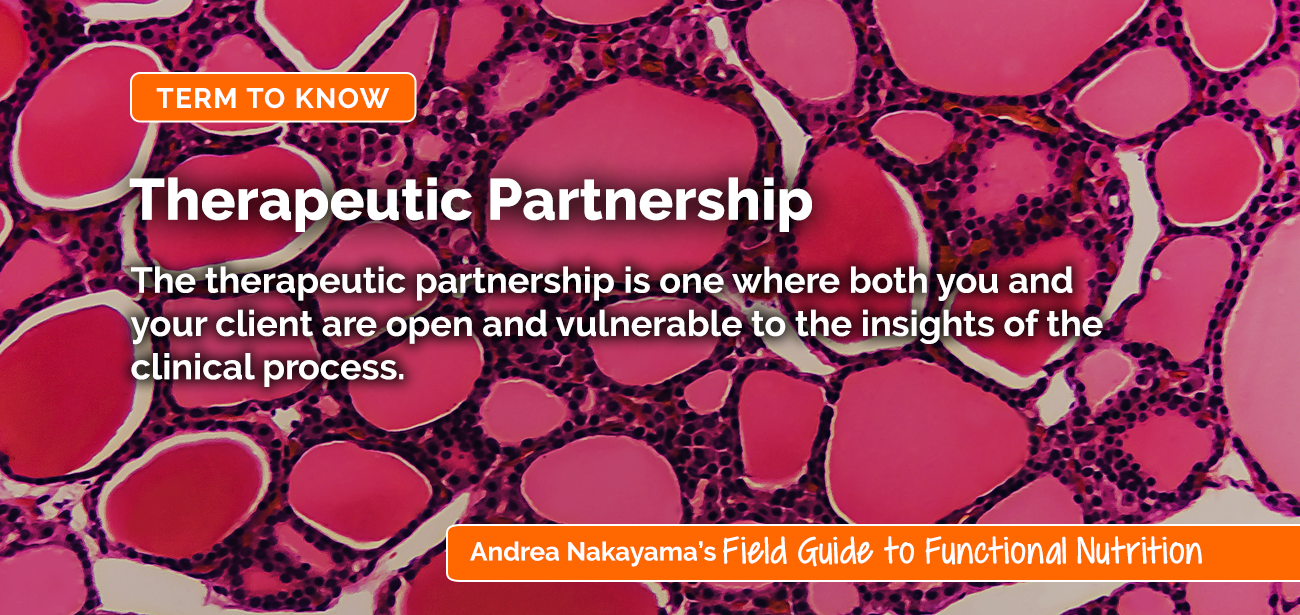Therapeutic Partnership
Posted by Andrea Nakayama

Listen to this post instead!
One of my favorite tenets of the Functional Medicine model is that of the therapeutic partnership—a constructive relationship established between patient and practitioner.
Yet my concern with the common interpretation of this term is that we continue to put pressures and expectations on the practitioner to walk over hot coals or extend herself beyond reason, without a full understanding of what a therapeutic partnership actually entails.
It’s not one where you become the servant to your client’s every whim. Nor is it one where your client simply listens to your wisdom (without sharing her own) and takes orders.
So, what is a real therapeutic partnership?
Great question!
Vulnerability
The therapeutic partnership is one where both you, the practitioner, and your client are open and vulnerable to the insights revealed by the clinical process.
You’re vulnerable, not because you share your own life saga, but because you freely admit that you do not have a quick-fix.
Because you two are just getting to know each other, it’s not assumed (or it shouldn’t be) that you’d have all the answers to their every problem from the first encounter. (How could you?)
You do not have a magic pill or a silver bullet solution. What you do have is time, dedication, attention, physiological comprehension, and trustworthy frameworks that will help guide you towards the answers your client needs.
A therapeutic partnership is a relationship where history is established and connections are made that enable the clinician to see the appropriate path more clearly and the patient to make incremental and meaningful changes.
The therapeutic partnership slowly but surely changes the terrain for your client (which is where the healing really happens). Their internal terrain makes a shift through the diet, lifestyle and therapeutic interventions you employ, and the healing terrain (and potential) shift because the relationship itself changes the hormonal milieu.
Did you catch that last part? It’s so important, I’ll say it again:
The healing potential of your client will shift in response to your interactions with her because the relationship itself changes the hormonal milieu.
Trust and Empathy
Trust and empathy lead to a chemical environment that induces the healing potential. You have the opportunity to activate the transformation from stuck to healing with the practice of Functional empathy.
When both you and your client have the opportunity to be vulnerable in a way that only you can provide, two magical things happen:
- Answers are uncovered, and people who might have lost hope can now get well
- The relationship itself causes oxytocin to flow in both you and your client. This creates more trust and connection, while reducing your client’s desire for the quick-fix. In other words, the oxytocin helps her open up, comply, and stick to the goals you and she set.
The problem you’re facing in your practice today could be anything from noncompliance, to not finding resolution (root cause) for your clients, to feeling like your clients are holding back information or emotions, to feeling like you just don’t know enough to help them.
The solution is the therapeutic partnership. It’s the terrain in which healing happens.
Related Blog Posts:
Terrain
Root Cause
How to make empathy an asset instead of a liability in your practice
Part 1: What’s Functional and what’s not
Part 2: What’s Functional and what’s not
Part 3: What’s Functional and what’s not
EXPERIENCE A FREE TRAINING SERIES WITH ANDREA NAKAYAMA TO HELP YOU
Begin practicing functionally today!
MORE TO EXPLORE
You Might Also Like
Maya Simand: Cancer Survivor to Holistic Cancer Coach
Holistic cancer coach Maya Simand shares her inspiring journey to healing. Discover how Functional Nutrition education empowered her to overcome breast cancer and help others find hope through integrative approaches.
Read MoreEstrogen dominance and breast cancer prevention: A Functional Nutrition approach
Estrogen dominance is a key factor in ER+ breast cancer. This Functional Nutrition guide explores how estrogen dominance increases risk and provides practical strategies to balance hormones and support overall health.
Read MoreThe 3 Roots, Many Branches: A Functional Framework for Clinical Success
As practitioners or aspiring nutrition counselors, we’re all familiar with the frustration of watching people struggle with chronic illness, cycling through symptoms and diagnoses without resolution.
Read MorePutting Patients First with Patient-Centered Care
I recently read an account written by a primary care doctor (PCP) describing a patient who had been passed from one specialist to another—each one focusing on ordering tests, prescribing medications, and ultimately sending her off with more questions than answers. No one paused to truly listen to the patient’s story. No one asked about […]
Read More